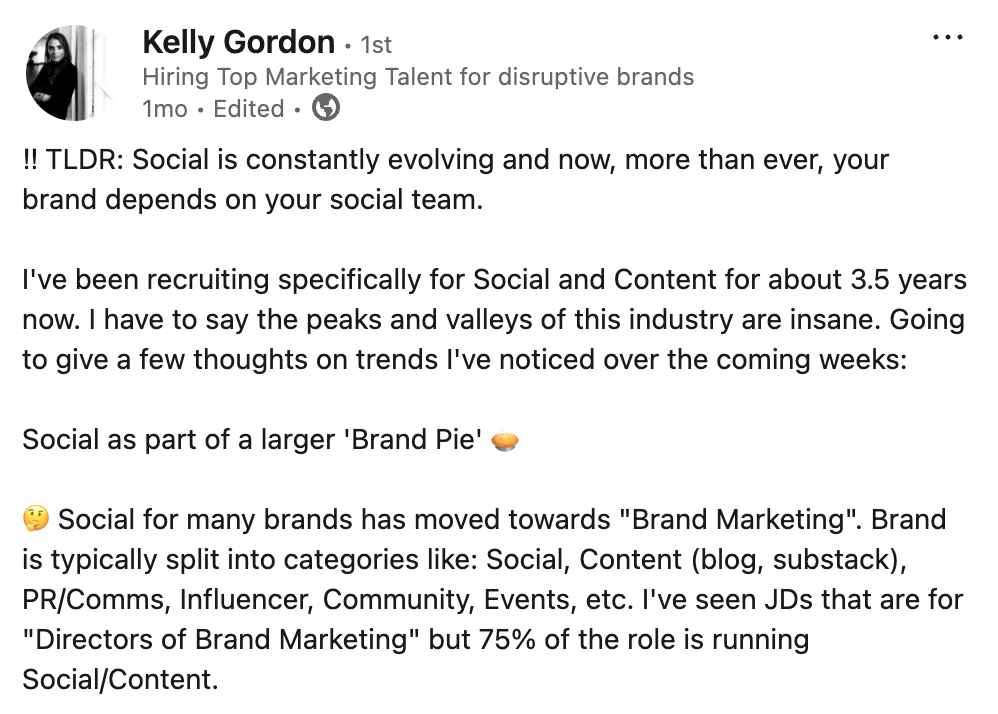I was last to the gift guides, and now I’m last to the EOY review. I’m rebranding my procrastination as ambition — a challenge to make it good enough to engage despite the fatigue.
I focused on trends that crystallized this year and how they’ll influence the year ahead. I could go on and on, but I had to cut myself off so I can actually enjoy these few days of “winter break.” These are top-of-mind and felt most impactful to me, from social and influencer to creative, culture and funding across consumer goods categories.
P.S. I just visited North Carolina for Christmas and it reminded me how much of a brand bubble we live in. Kendra Scott is likely going to do $750M+ this year, from bootstrapped beginnings and appropriately valued at $1B (more on funding trends below). My boyfriend’s niece and her friends are obsessed with Summer Fridays. They all know about Rhode (“the brand with the phone case lip gloss?”) but none of them have it.
Social became almost synonymous with brand
Social has become increasingly more central to brand building for a decade, but 2024 was the year people finally started saying “social is brand” out loud, and teams started explicitly hiring brand leadership roles that were majority social-focused. A recruiter recently reached out to me about a “VP of Brand” role for a beauty brand that is 90% social. Recruiter Kelly Gordon recently shared her first-hand insights on this trend:
That’s not to say that the rest of the marketing mix isn’t just as important — I’m a big believer in doing cool things to fuel social. But any initiative that isn’t amplified strategically on social leaves critical awareness/engagement on the table, which is another way of saying that social is the face of your brand marketing strategy.
At the same time, it’s become increasingly difficult for brands to drive awareness and engagement on organic owned social. That’s why strategy will be more important that ever in 2025, from creator and brand partnerships to feed-stopping creative.
Influencer became almost synonymous with growth
Don’t get me wrong, paid social still has a chokehold on plenty of brands. But this was the first year it felt like influencer took precedence for both DTC and retail-driven brands across categories (the former focused on affiliate, the latter on awareness). I’ve chatted with a few early-stage founders recently who are prioritizing influencer at the cost of owned social — I think that’s the move if you don’t have the right creative talent and your budget/resources are super limited.
Anecdotally, on the DTC side, leading brands like Dorsey and Phlur run on influencer (affiliate, whitelisting, influencer ads). On the retail side, leading brands like Bloom and Graza have proven that influencer (awareness) can be a primary driver of velocity.
Even on owned social, creator partnerships should be approached as amplification opportunities. In a people > brands world, even partners with a small following will drive more awareness and engagement than a brand with a small following — always prioritize amplification in your content budget.
Brands started taking retail marketing seriously
Digitally native omnichannel startup brands started taking retail — and as a result retail marketing — seriously, carving out real budget, strategy and roles focused on driving velocity.
Off the top of my head I can think of several brands that have or are looking to hire shopper/trade marketing managers to help execute ambitious 360 strategies involving merchandising, paid media, demos, POS and “old-school” tactics that have a halo effect on retail velocity like street sampling, localized OOH and experiential.
Fractional became the new freelance
Before you @ me with a lecture on the difference between freelance, fractional and consulting, what I mean is that more talent (and brands) went freelance thanks to the rise of the “fractional” leadership. As a result, startups like Veep and Fractional Jobs are popping up to solve for recruitment, while agencies like Creative People grew their contract divisions and platforms like MarketerHire saw exponential growth (fun-fact, I launched their newsletter years ago). I expect a lot more fractional startups to pop up in 2025.
Fragrance boomed
The fragrance space went from exciting to incredibly overwhelming in less than a year. At this point, you’d be hard-pressed to find a beauty brand, influencer or celebrity that hasn’t at least dabbled in fragrance in 2024, whether through perfume or further emphasis on scented product.
Body care brand Soft Services, previously intentionally fragrance-free, launched two limited-edition scented products, both allegedly bestsellers. Bolstered by You, Glossier’s two new fragrances also allegedly did really well. Merit aimed to cut through the noise for their fragrance launch with a campaign driven by their community’s perspectives instead of the traditional romantic campaign (while I respect the approach, I’m not sure how impactful I believe it was).
Saturation always raises the bar. I’m excited to watch this space in 2025 as brands are challenged to be even more thoughtful and strategic in their approach. That said, I can totally see a Rhode fragrance doing really well regardless of the approach.
Beauty M&A busted
We started the year thinking Glossier, Rare Beauty, and/or Makeup by Mario were going to get acquired, and none of the above happened. Puck’s Rachel Strugatz explained this one flawlessly, so I’ll just copy-paste here:
The inactivity indicates less about the brands than the overall market, itself. Makeup by Mario, Glossier, Rare, etcetera are all attractive assets with mostly strong financials, which would have sold for 10 figures several years ago. But the pullback by strategics, and oversaturation in one category (Rare, Makeup by Mario, Merit, and Kosas, after all, are all makeup companies) has submerged all boats.
There’s also the issue of valuation misalignment. Two recent exits, in particular, seriously distorted the market. In 2023, Unilever bought K18 and e.l.f. acquired Naturium at 25-30x EBITDA multiples, which seemed inflated then and preposterous now. But those numbers played on the economic erogenous zones of founders and bankers and long-suffering investors, all of whom hoped to keep the party going in 2024—only to find themselves entering a new macroeconomic climate that priced in inflation, uncertainty, and doubt.
As for what lies ahead in the new year:
I’m still holding out for 2025. Generally, the market seems more optimistic since the election, and there’s hope that interest rates will continue to tumble. Still, sellers will need to get over their delusions of grand valuations and meet potential buyers halfway.
Protein boomed
CHOMPS is the fastest growing food brand, full stop (I heard they’re spending $300K+ per-regional OOH campaign alone). Khloe Kardashian will launch a protein popcorn brand in 2025. While the space is hot, it doesn’t feel nearly as saturated as fragrance yet, and with the pendulum swing of diet culture I expect this space to keep booming well into the new year.
Plant-based busted
It feels like the realization that plant-based alternatives aren’t necessarily healthier reached critical mass this year. That said, brands that deliver generally superior products will continue to thrive, plant-based or not.
Bootstrapped boomed
Loose definition of “boomed”, but brands are increasingly bootstrapping or building with >$1M in funding as profitability becomes more important and both sides realize that VC doesn’t apply to CPG the same way it applies to tech. I believe the shift is a necessary correction (regardless of interest rates) and will continue to drive sharper strategy as brands no longer have the luxury of burning cash, funded or not.
I loved this BoF piece on growing bootstrapped beauty brands. TLDR:
“[Customer] acquisition is expensive for every brand, including big ones. But it’s the retention that gets you into the green side of the profit and loss statement,” she said. The slow and steady pace has worked for Curie: at the end of 2023, Walmart cold-messaged the brand; it’s now carried in 4,300 stores across the US, and revenue is eight figures. Rodial is in the process of completing registration processes to allow it launch in India, and is eyeing Latin America and Australia.
Despite the slower pace, Hatzistefanis said developing self-reliance had been worth it. “The minute you get easy money, you start spending it easily,” she said. “The danger is that you grow too fast and add too many retailers, and with them one minute you’re in, the next you’re out. The bus [eventually] stops.”
VC…is still figuring it out
As a result, CPG-focused VC funds will continue to navigate a go-forward strategy in 2025. A few of my investor friends are considering operations roles or transitioning to tech funds for career insurance. Some are more optimist.
Remember Kim Kardashian’s fund SKKY? She’s no longer managing it — they set out to raise $1B but only secured $121M. Leading early-stage consumer fund G9 Ventures just published a statement around “betting on the basics” and “playing the long game.” Of their 45+ cross-category investments, successful exits include SPANX (private equity) and On (IPO).
I’m curious to see how this plays out in 2025. Is there a future for CPG in VC, albeit more conservative? We’ll stay tuned.
Creative went hifi
While lofi didn’t go anywhere, hifi creative made a big comeback this year as brands fought for owned engagement. Notable examples include feed-stopping photography from creatives like Casey Zhang and Nicole Miller-Wong. On the video front, brands are going long-form with hit series like Alexis Bittar’s award-winning Margaeaux & Jules, and leveraging AI to create moments they could never pull off IRL.
Cultural rebellion went ironic
I ripped this articulation from @eugbrandstrat, who does a brilliant job breaking down culture through brands on TikTok. I recommend watching all of his videos, but this one is about how earnestly rebellious brands like Harley Davidson are out (“boomers doing cosplay”) and ironically rebellious brands like Liquid Death are in. Why? As he brilliantly articulates, consumers are “rebelling against meaning itself.” He mentions examples like Nutter Butter’s social and Vacation’s chaotic packaging. The trend became more ubiquitous this year but there’s still arbitrage left — he predicts it will continue to grow for the next 6-12 months. This aligns with the strategy for one of my new clients and I’m already having fun with it — more to come!
AI took hold
I’d be remiss not to mention AI beyond animated content. A year ago everyone I knew was like “idk about this” and now they’re like “Lol ChatGPT developed an entire marketing strategy for me.” On a serious note, further adoption of AI for both consumer-facing and BTS work will continue to accelerate the pace and scale of our work as marketers, for better or worse. My hope is that we continue to leverage AI to bolster our work vs do it for us.
I asked Claude.ai what it’s best at when it comes to brand marketing…the list doesn’t fit in a screenshot but here’s a preview:
If you made it this far, I predict 2025 will be your year. Join me in signing off until then.
P.S. I have ~10 hours/week free right for fractional/consulting work. To give you an idea of the range of work I do for clients, I’m currently supporting GTM for a really fun re-brand + nationwide retail rollout as Fractional Brand Director, and recently developed an elevated yet scrappy experiential marketing program for an early-stage brand. If you’re curious about working together or just want to connect, I’d love to chat. Hit me up here or here.








